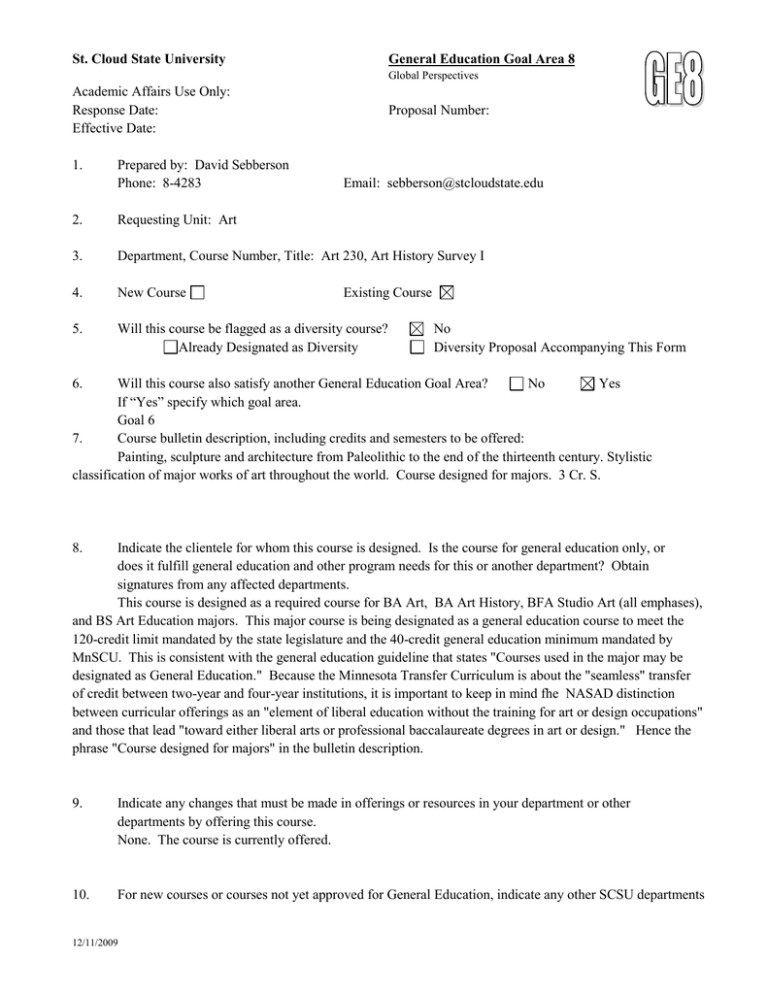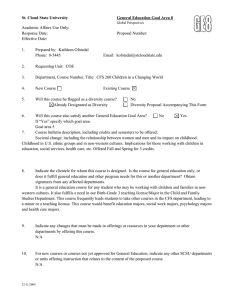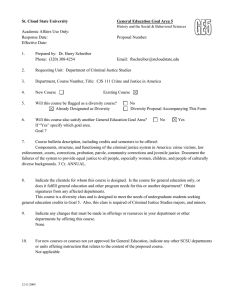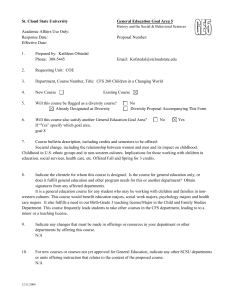GE-10-116. ART 230. Art History Survey I
advertisement

St. Cloud State University General Education Goal Area 8 Global Perspectives Academic Affairs Use Only: Response Date: Effective Date: 1. Prepared by: David Sebberson Phone: 8-4283 Proposal Number: Email: sebberson@stcloudstate.edu 2. Requesting Unit: Art 3. Department, Course Number, Title: Art 230, Art History Survey I 4. New Course 5. Will this course be flagged as a diversity course? Already Designated as Diversity Existing Course No Diversity Proposal Accompanying This Form 6. Will this course also satisfy another General Education Goal Area? No Yes If “Yes” specify which goal area. Goal 6 7. Course bulletin description, including credits and semesters to be offered: Painting, sculpture and architecture from Paleolithic to the end of the thirteenth century. Stylistic classification of major works of art throughout the world. Course designed for majors. 3 Cr. S. 8. Indicate the clientele for whom this course is designed. Is the course for general education only, or does it fulfill general education and other program needs for this or another department? Obtain signatures from any affected departments. This course is designed as a required course for BA Art, BA Art History, BFA Studio Art (all emphases), and BS Art Education majors. This major course is being designated as a general education course to meet the 120-credit limit mandated by the state legislature and the 40-credit general education minimum mandated by MnSCU. This is consistent with the general education guideline that states "Courses used in the major may be designated as General Education." Because the Minnesota Transfer Curriculum is about the "seamless" transfer of credit between two-year and four-year institutions, it is important to keep in mind fhe NASAD distinction between curricular offerings as an "element of liberal education without the training for art or design occupations" and those that lead "toward either liberal arts or professional baccalaureate degrees in art or design." Hence the phrase "Course designed for majors" in the bulletin description. 9. Indicate any changes that must be made in offerings or resources in your department or other departments by offering this course. None. The course is currently offered. 10. For new courses or courses not yet approved for General Education, indicate any other SCSU departments 12/11/2009 or units offering instruction that relates to the content of the proposed course. No other department offers courses whose content is art history and that meet both major requirements and general education requirements. 11. Courses designated as General Education are included in the assessment plan for the Goal Area(s) for which they are approved. Courses for which assessment is not included in the annual GE assessment report for two years will be removed from the General Education Program. The Requesting Unit understands and recognizes the above conditions. 12. Provide a concise explanation of how the following goal is a “significant focus” of the proposed course. Goal Area 8: Global Perspectives Develop a comparative perspective and understanding of one’s place in a global context. First, the bulletin description states explicitly that the course examines art from "throughout the world." Second, according to its original curriculm documents, Art History Survey I has as three of its five goals, the following, which directly address "understanding one's place in a global context": 1. To develop the student’s appreciation of the creative spirit and of the variety of human cultures. 2. To develop an understanding of the cultural and ideological context out of which artistic styles and movements have developed. 4. To serve as a source of images, ideas and standards for those involved in creative production and evaluation. Art students learn to situate themselves in the world by learning a variety of art making practices, informed by research and study of images, ideas and standards from a variety of sources. This required course provides students with a source of images that will enable them "to understand their place in a global context" by focusing on a "variety of human cultures" and the "cultural and ideological contexts" informing styles and movements that give shape to their own practices and understanding as artists, art educators, and art historians. Third, the course outline of topics listed below indicates that the entire content of the course is focused on global contexts. 13. In order for a course to be designated as fulfilling Goal Area 8, it must address at least 4 of the 5 student learning outcomes (SLOs) below. Check the SLOs below that are focused on in the proposed general education course. 1. Explain how they are connected and related to people elsewhere in the world. 2. Describe similarities and differences among global places and populations. 3. Analyze how political, economic or cultural elements influence relations among the world’s states, peoples, or societies. 4. Analyze specific international issues and propose and evaluate responses. 5. Articulate a vision of their individual roles and responsibilities in a common global future. 14. Discuss how each Student Learning Outcome checked above is achieved in this course. (Note: Although descriptions of typical assignments or types of assignments may be part of this discussion, it is not appropriate to submit copies of actual assignments.) 12/11/2009 1. As students study the topics in the course outline below, they are learning about the connections with and relations to their own perspectives on art and those of the global cultures studied in the course. Students explain these connections through tests, papers, presentaions, or responses. 2. When students study the bodily ease of a Praxitelian sculpture, for example, and the spiritual formality of the Madonna Enthroned by Cimabue, they are studying not simply individual expressions of significant artists, but also the collective values expressed in those works, contextualized by pre-Helenistic Greece in the first case, and late medieval Christian Europe in the second. Through tests, papers, presentations, or responses students must describe similarities and differences of art works in the contexts of where they exist and the collective values of the populations that produced them. Students repeat this practice as they work through the variety of global cultures listed in the course outline. 3. Students analyze the cultural contexts that both shape art and architecture and that are given material form and expression in art and architecture. What gives shape to and is expressed in the Roman Temple of Fortuna Virilis (2nd C. BCE)? The ziggurat attached to the Great Mosque at Samara (848-852 CE)? The nave of Chartres Cathedral (1192 - 1220 CE)? What aspects of cultural identity do they give shape to? What were the relations between societies that built, destroyed, or converted architectural monuments of different religious beliefs and what are the visual elements that make those relations visible? In addition, art history courses routinely raise questions such as these: What are the historical, political, and economic contexts that produced the Lindisfarne Gospels, destroyed the abbey where they were produced, and put an end to illuminated manuscripts as an economically viable means of production? 5. Art majors develop their visions as artists, art historians, and art educators in part through the study of art created by a variety of cultures that have existed throughout human history. In this course, through tests, papers, presentations, or responses, they articulate their own understanding of globally produced art, which undergirds their own studio, educational, and historical practices. 15. List or attach the Course Outline (adequately described and including percentage of time to be allocated to each topic). Curriculum Committees may request additional information. Topics larger than 20% need to be broken down further. Indicate in your course outline where the Student Learning Outcomes checked above are being met. The original outline for this course as it was approved through the curriculum process consists of 15 topics, listed below with their percentages. This outline is not being changed. In convering these topics, students read and attend lectures about them. They must also take tests and/or prepare papers, presentations, or repsonses that collectively cover the course topics. Through the array of these practices and topics, students explain connections about art produced by people elsewhere in the world (SLO 1), describe similarities and differences about art that is produced in different places by different peoples (SLO 2), analyze how art is shaped by cultural, political, or econcomic contexts and how art expresses relations or is a nexus of relations among the world states, peoples or societies (SLO 3), and articulate their individual roles and responsibilities as artists, art historians or art educators living and working in a global context. 1. 2. 3. 4. Prehistoric and Ethnographic Art (6.66%) Egyptian Art (6.66%) Ancient Near Eastern Art (6.66%) Aegean and Greek Art (6.66%) 12/11/2009 5. 6. 7. 8. 9. 10. 11. 12. 13. 14. 15. Greek Art (6.66%) Etruscan and Roman Art (6.66%) Early Christian and Byzantine Art (6.66%) Islamic Art and Early Medieval Art (6.66%) Romanesque Art (6.66%) Gothic Art (6.66%) Indian Art (6.66%) Chinese Art (6.66%) Japanese Art (6.66%) The Americas (6.66%) African Art (6.66%) 12/11/2009 St. Cloud State University General Education Transmittal Form Academic Affairs Use Only: Response Date: Effective Date: Proposal Number Department: Art Course or Course(s): Art 230, Art History Survey I David Sebberson Department or Unit Chair Signature January 30, 2010 Date Department forward to Academic Affairs for publication and electronically to Chair of General Education Committee, Chair of College Curriculum Committee, College Dean Recommendation of General Education Committee: Approve Remarks: Disapprove Chairperson Committee Signature Date Recommendation of University Curriculum Committee: Approve Remarks: Disapprove Chairperson Committee Signature Date Recommendation of Faculty Association: Approve Remarks: Disapprove FA Senate Signature Date Action of Academic Vice President: Approve Disapprove Signature Entered in Curriculum Data File 12/11/2009 Remarks: Date









